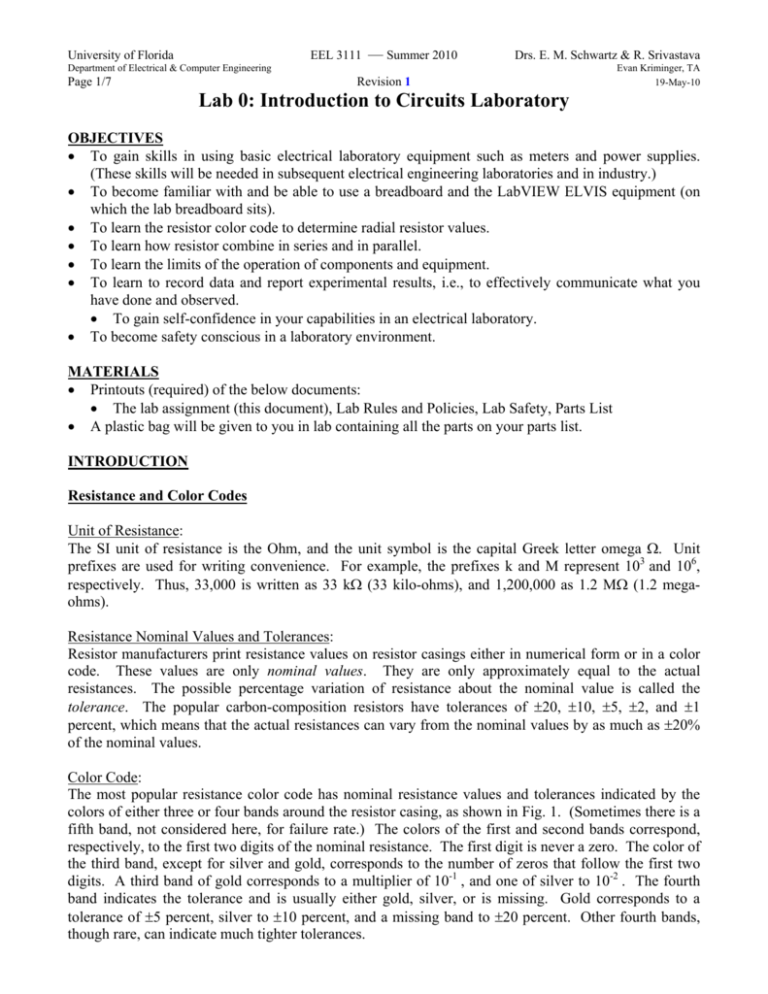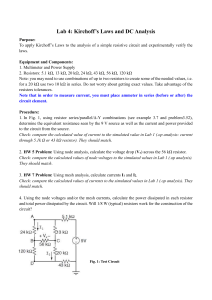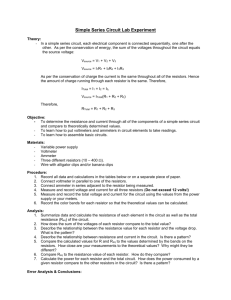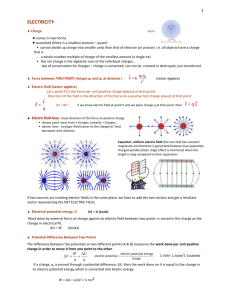1 Lab 0: Introduction to Circuits Laboratory
advertisement

EEL 3111 — Summer 2010 University of Florida Drs. E. M. Schwartz & R. Srivastava Department of Electrical & Computer Engineering Page 1/7 Revision 1 Evan Kriminger, TA 19-May-10 Lab 0: Introduction to Circuits Laboratory OBJECTIVES To gain skills in using basic electrical laboratory equipment such as meters and power supplies. (These skills will be needed in subsequent electrical engineering laboratories and in industry.) To become familiar with and be able to use a breadboard and the LabVIEW ELVIS equipment (on which the lab breadboard sits). To learn the resistor color code to determine radial resistor values. To learn how resistor combine in series and in parallel. To learn the limits of the operation of components and equipment. To learn to record data and report experimental results, i.e., to effectively communicate what you have done and observed. To gain self-confidence in your capabilities in an electrical laboratory. To become safety conscious in a laboratory environment. MATERIALS Printouts (required) of the below documents: The lab assignment (this document), Lab Rules and Policies, Lab Safety, Parts List A plastic bag will be given to you in lab containing all the parts on your parts list. INTRODUCTION Resistance and Color Codes Unit of Resistance: The SI unit of resistance is the Ohm, and the unit symbol is the capital Greek letter omega Unit prefixes are used for writing convenience. For example, the prefixes k and M represent 103 and 106, respectively. Thus, 33,000 is written as 33 k (33 kilo-ohms), and 1,200,000 as 1.2 M (1.2 megaohms). Resistance Nominal Values and Tolerances: Resistor manufacturers print resistance values on resistor casings either in numerical form or in a color code. These values are only nominal values. They are only approximately equal to the actual resistances. The possible percentage variation of resistance about the nominal value is called the tolerance. The popular carbon-composition resistors have tolerances of 20, 10, 5, 2, and 1 percent, which means that the actual resistances can vary from the nominal values by as much as 20% of the nominal values. Color Code: The most popular resistance color code has nominal resistance values and tolerances indicated by the colors of either three or four bands around the resistor casing, as shown in Fig. 1. (Sometimes there is a fifth band, not considered here, for failure rate.) The colors of the first and second bands correspond, respectively, to the first two digits of the nominal resistance. The first digit is never a zero. The color of the third band, except for silver and gold, corresponds to the number of zeros that follow the first two digits. A third band of gold corresponds to a multiplier of 10-1 , and one of silver to 10-2 . The fourth band indicates the tolerance and is usually either gold, silver, or is missing. Gold corresponds to a tolerance of 5 percent, silver to 10 percent, and a missing band to 20 percent. Other fourth bands, though rare, can indicate much tighter tolerances. EEL 3111 — Summer 2010 University of Florida Drs. E. M. Schwartz & R. Srivastava Department of Electrical & Computer Engineering Page 2/7 Revision 1 Evan Kriminger, TA 19-May-10 Lab 0: Introduction to Circuits Laboratory The resistor in Figure 1, shows color bands of red, violet, green and brown. The red and violet color bands correspond to the digits 2 and 7 respectively; the green band contributes a multiplier of 105. The brown band signifies a tolerance of 1%. The value of the below resistor is therefore 27105 = 2.7106 , but is normally written as 2.7 M 1%. Figure 1 – Resistor color banding. Value is 2.7 M 1%. See also Table 1. The resistance color code is shown in Table 1. A resistor with bands of red, yellow, orange, and gold has resistance of 24 k 5%. A resistor with bands of blue, gray, yellow, and silver has resistance of 680 k10%. And, a 1 20% resistor has color bands of brown, black, gold, and no fourth band. Since the first digit is never zero, then the first color band is never black. Color Black Brown Red Orange Yellow Green Blue Violet Gray White Gold Silver None 1st & 2nd Bands (Digits) 0 1 2 3 4 5 6 7 8 9 – – – 3rd Band 4th Band (Multiplier) (Tolerance) 100 – 1 ×10 ±1% 2 ×10 ±2% 3 ×10 – 4 ×10 – ×105 ±0.5% ×106 ±0.25% 7 ×10 ±0.1% 8 ×10 ±0.05% 9 ×10 – -1 ×10 ±5% ×10-2 ±10% – ±20% Table 1 – Resistor color code. See also Figure 1. Breadboard Description Most of the circuits built and tested in this laboratory will be assembled on a “breadboard,” which looks like a piece of plastic with holes in it, as shown in Figure 1. Electrical components (resistors, capacitors, wires, etc.) are inserted into the holes. What makes a breadboard unique is that certain combinations of the holes are electrically connected with each other. These connections are hidden inside the plastic. EEL 3111 — Summer 2010 University of Florida Drs. E. M. Schwartz & R. Srivastava Department of Electrical & Computer Engineering Page 3/7 Evan Kriminger, TA 19-May-10 Revision 1 Lab 0: Introduction to Circuits Laboratory Thus, a user must know which holes are connected. Most breadboards have a similar pattern of interconnections. Fig. 2 – A typical breadboard. Breadboard Connections: The internal connections inside the breadboard run in both vertical and horizontal lines, as shown in Fig. 2. Some important facts about breadboards are The vertical connections are in groups of five. Each of the group of five holes are connected. Each horizontal row has all its holes connected No column is connected to any other column, no row is connected to any other row, and no column is connected to any row. The spacing between adjacent holes in a row (or column) is 0.1 inch. Figure 4 ‒ Close-up of connections on a breadboard. Figure 3 – The hidden connections of the breadboard of Figure 2. Separate components are connected together at one point (called a node) by inserting the proper component(s) into the proper breadboard holes. The advantage of using a breadboard is that relatively large circuits can Figure 5 ‒ Alligator clip. be assembled neatly without having a maze of interconnecting wires. Further, when connections must be made from the assembled circuit to external equipment, such as power supplies and meters, leads with alligator clips (see Figure 5) on one or both ends can be used. The alligator clips are connected directly to the circuit components. A circuit should be assembled and checked before any external connections are made. NI ELVIS Our experiments will be conducted using the National Instruments Educational Laboratory Virtual Instrumentation Suite (NI ELVIS). ELVIS includes features such as power supplies, measurement tools, and signal generators. These features are controlled through the NI ELVIS application on the computer desktop. The interface is powered by LabVIEW. EEL 3111 — Summer 2010 University of Florida Drs. E. M. Schwartz & R. Srivastava Department of Electrical & Computer Engineering Page 4/7 Revision 1 Evan Kriminger, TA 19-May-10 Lab 0: Introduction to Circuits Laboratory Variable Power Supply and Ground The DC power supply used in this lab can be accessed by selecting “Variable Power Supply” on the NI ELVIS menu. There is a negative power supply and a positive one. These are two separate supplies, they do not function like the + and – terminal of a battery. The range of the negative supply is 0 to 12 V, while the range of the positive supply is 0 to +12 V. The ELVIS board has a row of four connections next to each supply, labeled “Supply +” and “Supply ‒”. Between the two supply rows are the connections for ground.. Each power supply is internally grounded. This means that the low side of the voltage source is connected to ground and is inaccessible inside the ELVIS unit. Do not to ground the power supply. Connecting ground directly to the output of the power supply will blow a fuse (and hurt your grade). A typical circuit starts at “Supply +,” goes through a network of resistors and possibly other components, and returns to ground. This is a closed circuit because it starts at ground (inside the power supply) and returns to ground. Digital Multimeter (DMM) A DMM is a multipurpose tool for measuring circuit values such as voltage, current, and resistance. A voltage measuring device is called a voltmeter. To measure voltage, attach the red lead of the DMM to the port on the right side, labeled V, and select VDC with the knob. Measure voltage by attaching the leads of the DMM to the terminals of desired element. Be sure to maintain the sign convention of the circuit diagram. Attach the red lead to the point on the circuit marked with a + symbol and the black lead to the point with – symbol. In Fig 6, we are attempting to measure VOUT, the voltage across resistor R2. Figure 6: The circuit on the left shows the voltage, VOUT, to be measured. The circuit on the right shows the connections for the DMM. A current measuring device is known as an ammeter. To put the DMM in ammeter mode, attach the red lead to the left side port of the meter, and select IDC with the knob. There are two ports for current, which differ in the maximum current they can measure. If you try to measure a current that is too large for the port, the fuse will blow. The fuse values are labeled on the DMM. To measure current, break the circuit open where the current is to be measured and insert the meter to re-close the circuit. In Fig. 7, we are attempting to measure the series current, I. EEL 3111 — Summer 2010 University of Florida Drs. E. M. Schwartz & R. Srivastava Department of Electrical & Computer Engineering Page 5/7 Evan Kriminger, TA 19-May-10 Revision 1 Lab 0: Introduction to Circuits Laboratory Figure 7: The circuit on the left shows the current, I, to be measured. The circuit on the right shows the connections for the DMM. Notice the sign convention for current measurement. Short Circuit An element is short circuits (shorted) when its terminals are connected, usually with a piece of wire (but a metal ring or bracelet will do just as well). When a resistor (or any other device) is short circuited, current will completely bypass the resistor because the short circuit provides a more desirable path since a short circuit has zero resistance. Fig. 8 shows a short circuited resistor. Avoid short circuits in your circuits. Figure 8: A resistor (left) and a short circuited resistor (right). Series and Parallel Resistors When resistors are connected in series (as shown in Fig. 9), the terminal of one resistor is connected directly to the terminal of the next resistor, with no other possible paths. When resistors are in series, they are equivalent to a single resistor with a resistance equal to the sum of the series resistances, i.e., RSERIES = R1 + R2 + R3 + … Figure 9: Series resistors, RSERIES = R1 + R2 + R3 + … When resistors are in parallel (as shown in Figure 10), all of their first terminals are connected together, and all of their second terminals are connected together. When resistors are in parallel, they are equivalent to a single resistor whose value is given by the following equation: ଵ ோೌೝೌ ൌ ଵ ோభ ଵ ோమ ଵ ோయ ڮor ܴ ൌ ଵ భ భ భ ା ା ାڮ ೃభ ೃమ ೃయ EEL 3111 — Summer 2010 University of Florida Drs. E. M. Schwartz & R. Srivastava Department of Electrical & Computer Engineering Page 6/7 Evan Kriminger, TA 19-May-10 Revision 1 Lab 0: Introduction to Circuits Laboratory Figure 10: Parallel resistors, ܴ ൌ ଵ భ భ భ. ା ା ೃభ ೃమ ೃయ PRE-LAB AND QUESTIONS Go to NEB 288 and get an ECEL Cluster account BEFORE your lab. There is a machine to the right of the door. You will need to scan your Gator ID in order to setup your account. This account is needed in order to use the computers in our 3111 Lab. 1. Printout the required documents in the MATERIAL’s section and bring them to your lab. 2. A resistor is placed on the breadboard above between two of the marked points. State whether the resistor is shorted (terminals of the resistor are connected) or if its terminals are unconnected. a. Resistor between A and B. b. Resistor between A and C. c. Resistor between D and E. d. Resistor between E and H. 3. Two resistors are placed on the breadboard above. State whether the two resistors are connected in parallel, in series, or not connected. a. First resistor between D and F. Second resistor between G and H. b. First resistor between C and D. Second resistor between E and H. c. First resistor between A and D. Second resistor between C and E. 4. Given the color combination, specify the resistor value (you do not need to write the tolerance). a. Red, orange, brown, gold b. Orange, orange, orange, gold c. Brown, gray, yellow, gold d. Green, blue, red, gold EEL 3111 — Summer 2010 University of Florida Drs. E. M. Schwartz & R. Srivastava Department of Electrical & Computer Engineering Page 7/7 Revision 1 Evan Kriminger, TA 19-May-10 Lab 0: Introduction to Circuits Laboratory Figure 11: Resistor network for problem 3. All values in ohms. 5. Answer the following questions about the resistor network of Fig. 11 a. Are any of the six labeled resistors in parallel? If so, which ones. b. Are any group(s) of resistors are in series? If so, which ones. If so, simplify the circuit by reducing all series connections.. Draw the new circuit and label all resistor values. c. How many groups of parallel resistors are in the simplified network from (b). d. Reduce the entire network to a single resistor. What is the equivalent resistance for the circuit of Fig. 9? LAB PROCEDURE AND QUESTIONS 1. Set up the series circuit in Fig. 10. Use the variable power supply and remember to return the circuit to ground. 2. What is the value that you expect for V2? Measure the voltage V2 with the DMM. Why don’t they match? 3. What is the value that you expect for the current in the circuit? Measure the current with the DMM. 4. Is Ohm’s Law satisfied for R3? Explain. 5. Replace the three series resistors with a single resistor, RSERIES, of equal value. Measure the current through this resistor. Is the current equal to the current in the original circuit? If not, why not? 6. Measure the voltage across RSERIES. 7. Is Ohm’s Law is satisfied for the new resistor? Explain. Figure 10: The voltage supply value is in volts and the resistance values are in ohms.








